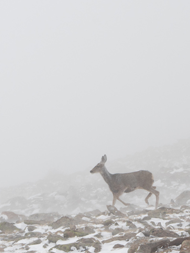
Why Is Balancing Recreation and Natural Resources a Challenge?
Colorado has no short order of places to go, things to see and adventures to be had.
Colorado’s public lands, recreation opportunities and wildlife are among its most valuable resources. Our quality of life, outdoor heritage and prosperity are tied to the health and sustainability of these treasures. In order to manage the resources and protect the lifestyle that makes Colorado so special, we need to find ways to balance outdoor recreation and natural resource conservation.
Enjoyment of Colorado’s abundant and diverse outdoor recreational opportunities, by residents and visitors alike helps to deliver the outdoor economic horsepower to the state. However, these outdoor pursuits can also have the potential to disturb, alter and destroy wildlife and habitat if not well managed or cared for by those recreating.
What Are Some Examples of Colorado's Many Outdoor Opportunities?
These resources define our state and who we are. As our population grows, more people are participating in our outdoor recreation opportunities. With that, comes a greater responsibility to take care of and invest in what sustains us.
People play outside for many reasons, two of which are better lifestyle and to reduce stress from the daily grind. All Coloradans benefit from healthy parks and abundant wildlife because they bring us a sense of place and purpose.
Recreation needs conservation, otherwise we have no place to play, and conservation needs recreation. Our wild spaces, our wildlife and natural resources need people to care enough to invest in them for the long term.
Recreational activities: hunting, fishing, off-highway vehicles, motorboats, jet-skiing, snowmobiling, mountain biking, hiking, birdwatching, skiing, snowshoeing, paddle boarding, taking our pets in recreational areas, camping and rock-climbing.
What Are The Effects?
These places, our public lands, parks and wildlife... their habitat, are a vital part of Colorado’s heartbeat, they have shaped our past—they shape our lives today and we must begin to shape our future or it will shape us.
How do we want that future to look?
Outdoor recreation in natural areas often requires access roads and trails, which can fragment habitat if not planned for regular use and with wildlife in mind.
The presence of humans and their domesticated animals can disturb wildlife and cause negative behavioral changes: abandonment of nest sites, feeding areas, and wintering grounds.
Social trails can cause erosion, damage to plants and disturb wildlife. They are not planned trails or maintained by anyone which can lead to increased destruction of the area.
Unmanaged motorized recreation can lead to increased erosion and sedimentation, aid in noxious weed dispersal, and disturb wildlife through an unpredictable human presence and vehicle noise.
What Is CPW Doing?

Colorado became the first state to adopt the Principles for Advancing Outdoor Recreation and Conservation, commonly referred to as the SHIFT(shaping how we invest for tomorrow) that originated out of Jackson Hole, WY. Colorado adapted these principles to meet the demographic needs of our beautiful state. With CPW's robust Partners in the Outdoors program, staff work tirelessly to build bridges across user groups to ensure a common ethic and set of core values when working and playing in the outdoors.
Colorado’s state parks are a respite for both humans and animals alike. However, human disturbance, either through recreation or simple presence, can significantly impact many of our most beloved species. CPW’s resource stewardship team takes great care to guide park managers in the development of opportunities for human enjoyment, while preserving an undisturbed and suitable habitat for the wildlife calling our parks home.
CPW also works closely with volunteers to help educate and work with the public on embracing the Leave No Trace principles.
Refraining from disturbing wildlife in the winter is particularly important, as many animals are already strained from the cold and reduced resource availability. An unnecessary scare can result in a fatal loss of energy. CPW works to educate outdoor recreators and wildlife viewers in ethical activities through
online resources and timely winter reminders.

